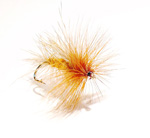Jocassee Gorges a prime destination for trout enthusiasts
The state’s prized 50 square miles of mountain habitat known as the Jocassee Gorges contains some of the highest quality water resources anywhere. Yet things are getting even better, according to the wildlife biologist and forester who manages the Jocassee project in northern Pickens and Oconee counties.
“We have some excellent trout fishing opportunities in the Jocassee Gorges,” said Mark Hall of the S.C. Department of Natural Resources (DNR), an avid fly fisherman who relishes opportunities to enhance water quality, trout streams and the quarry he likes to find at the end of his fly line — the brook, brown or rainbow trout.
[cointent_lockedcontent]
The Eastatoee River and its headwaters support an incredible diversity of aquatic life in terms of invertebrates, salamanders, snakes, frogs and trout, according to Hall.
“Just turn over any rock in the stream and you’ll find stoneflies, caddisflies, mayflies and their allies,” Hall said.
Popular Jocassee trout streams include the Eastatoee, Whitewater, and Thompson rivers, Howard, Limberpole, Wright, Reedy Cove , Laurel Fork, Cane, Abner, Rocky Bottom, Willis and Emory creeks. Some larger Jocassee streams support both stocked and wild rainbow and brown trout. The best larger wild trout streams in the Jocassee Gorges include: Howard Creek, Eastatoee Creek (from the heritage preserve upstream), Whitewater, and Thompson rivers. Portions of all of these streams boast populations of self-sustaining wild trout. In general, the streams that can be easily accessed by vehicle support plenty of stocked trout during the spring and summer months.

OLYMPUS DIGITAL CAMERA
Special to The Courier
Jocassee Gorges offers excellent trout fishing opportunities.
The DNR Freshwater Fisheries Section also manages sections of most of the aforementioned streams as hatchery-supported trout streams during the cooler seasons of the year. Some streams receive weekly stockings of catchable sized trout during late-winter, spring and early summer months, and bi-monthly stockings during the fall, according to Dan Rankin, DNR regional fisheries coordinator and trout biologist.
“The DNR stocks more than 80,000 catchable-size trout in the Jocassee Gorges area each year,” Rankin said. Backcountry streams that do not currently support viable wild trout populations, such as Laurel Fork and Cane creeks, are also stocked seasonally with trout to provide good backcountry fishing opportunities. In addition, two new “delayed harvest” stream segments were recently added on lower Eastatoee River and Howard Creek. These delayed harvest areas are stocked heavily by DNR and managed as catch-and-release during the cooler months, which optimizes the chances that trout anglers will have a great fishing experience.
 Access weekly trout stocking updates by visiting the DNR stocking report. The DNR’s Trout Fishing Guide also provides valuable information on access and management of Jocassee area trout streams. Hard copy can be obtained by calling (864) 654-6346, extension 24.
Access weekly trout stocking updates by visiting the DNR stocking report. The DNR’s Trout Fishing Guide also provides valuable information on access and management of Jocassee area trout streams. Hard copy can be obtained by calling (864) 654-6346, extension 24.
Some creeks that require long hikes and foot trail access do support wild, reproducing populations of trout. Examples of good “blue line” wild trout fishing streams include Limberpole, Wright, Emory, and upper Howard creeks.
However, a recent study by DNR Freshwater Fisheries Section staff revealed that numerous high-elevation, headwater Jocassee streams are devoid of trout. The study identified limited pool habitat and cover for trout as the primary deficiency in these streams. DNR staff are already working to restore these headwater habitats in two streams on Jocassee with a goal of introducing native brook trout to these fishless stream reaches in coming months. DNR staff recently felled and downed numerous trees in upper Laurel Fork and Emory creeks.
Studies have found that large trees in such streams facilitated the transport of sediments downstream, and provided crucial cover for trout and the food they require.
Editor’s note: This article came from the archives of the South Carolina Department of Natural Resources, and some information may have changed since its original publication in 2013. Visit dnr.sc.gov for more information.
[/cointent_lockedcontent]




























